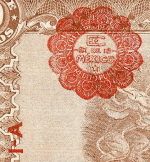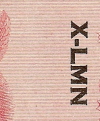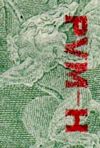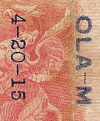Serial numbers and codes on the dos caritas
Serial numbers were applied at the printers, whilst the validation seal and control letters were applied at the Tesorería offices in Ciudad Juárez and later ChihuahuaThe Villistas bought seals from the John C Ranking Co. on 15 October 1914 and a maquina selladora from the American Multigraph Co. on 24 October 1914 (LG papers, 4-A-10). On 16 February 1915 Vargas asked for another twelve metal seals for the stamping machines (LG papers, 6-E-13, telegram N. M. Sanchez, Washington, to Navarro, San Antonio, 16 February 1915) and Navarro asked de la Garza for the original (LG papers, 6-E-14, telegram Navarro, San Antonio, to L. de la Garza, El Paso, 16 February 1915) which de la Garza sent by registered post the next day (LG paper, 6-E-18, letter de la Garza, El Paso, to Navarro, Washington, 17 February 191). On 18 February the order was increased to twentyfive seals (LG papers, 6-E-19, telegram N. M. Sanchez, Washington, to Navarro, San Antonio, 18 February 1915). Notes were dispatched from the printers in batches and could be held up en route, at the express or customs offices. The Tesorería offices must also at any time have been holding large quantities of stamped and unstamped notes, and stock control may have been poor. Because of these factors the alphabetic control codes, which appear to have been applied in small batches, do not always mirror the sequential numbering, though codes do appear to tally with the number ranges of the various different orders. In fact, a mismatch between control letters and such number ranges is prima facie evidence of a forgery.
The codes have a basic chronological sequence, namely:
| Type | ||
|---|---|---|
| 1 | A vertical pair with Roman numerals and the letters of a patriotic phrase. These were used with the Ejército Constitucionalista seal, and are in a similar format to the Ejército Constitucionalista notes |  |
| 2 | Two, three or (very rarely) four letter codes separated by hyphens | |
| 3a | Letters of the alphabet followed by a pseudo-Roman number (i.e. made up from the letters used as Roman numerals but not always actual Roman numbers) | |
| 3b | Letters of the alphabet followed by a pseudo-Roman number in a thinner font | |
| 3c | Letters of the alphabet followed by a three (occasionally four) letter code. These are in a serif font as other Type 3, but use non-Roman letters | |
| 4 | Letters of the alphabet followed by a four letter code. These are not a sequence but isolated examples | |
| 5 | Letters of the alphabet followed by a three (occasionally two) letter code | |
| 6 | A three letter code followed by the letters of the alphabet | |
| 7 | Letters of the alphabet followed by a three (occasionally two) letter code and date |  |
| 8 | Three letter code followed by the letters of the alphabet with date |  |
| 9 | Double letter followed by two letter code and date |  |
| 10 | Double letter followed by three letter code | |
| 11 | Two letter code followed by double letter and date |  |
| 11a | Two letter code followed by double letter and date (thinner serif font) |  |
| 12 | Three letter code followed by double letter and date |  |
| 12a | Three letter code followed by double letter and date (thinner serif font) |  |
But there were anomalies.
Similarly, there is some chronological sequence to the use of a circular and then a scalloped Tesorería seal, and in the colour of ink used, but again with anomalies.
The key to the control letters was probably some cipher. Occasionally, some pattern can be discerned, for example in the late progression in AOY-CC, BPZ-DD, CQA-EE, and DRB-FF. However, it is difficult to explain the aberrations, namely duplication in the use of initial letters, e.g. $1 notes with T-AMR, T-IMU, T-SEA; reuse of particular codes with different fonts or seals, and late curiosities such as ARMAN-DO and -ALP-.
As part of the printing process the hyphen in the letter codes was occasionally missed and the hyphens in the date either missed or printed as “=”.
There are also occasionally differences in the thickness and length of the hyphen in the control codes.
Vertical codes
Inverted seals and codes were the result of the notes being fed in to the stamping machine the wrong way round and so are nothing more than a numismatic curiosity. However, on all values certain codes were printed vertically, and this requires greater consideration.
The codes were variations on the horizontal codes thus:
| Type | ||
|---|---|---|
| 5v | Letters of the alphabet followed by a three letter code |  |
| 6v | A three letter code followed by the letters of the alphabet |  |
| 8v | Three letter code followed by the letters of the alphabet with date |  |
| 9v | Double letter followed by two letter code and date |
These appear to have been printed on the same machines as the horizontal codes, as both versions of O-LDC have a misaligned ‘O’. All the known vertical codes have horizontal equivalents, so probably there was a mundane practical reason. Perhaps some sheets of notes were cut in a way that meant they had to be rotated to feed into the stamping machines.
Those codes that have dates range from 27 March 1915 to 20 June 1915.
